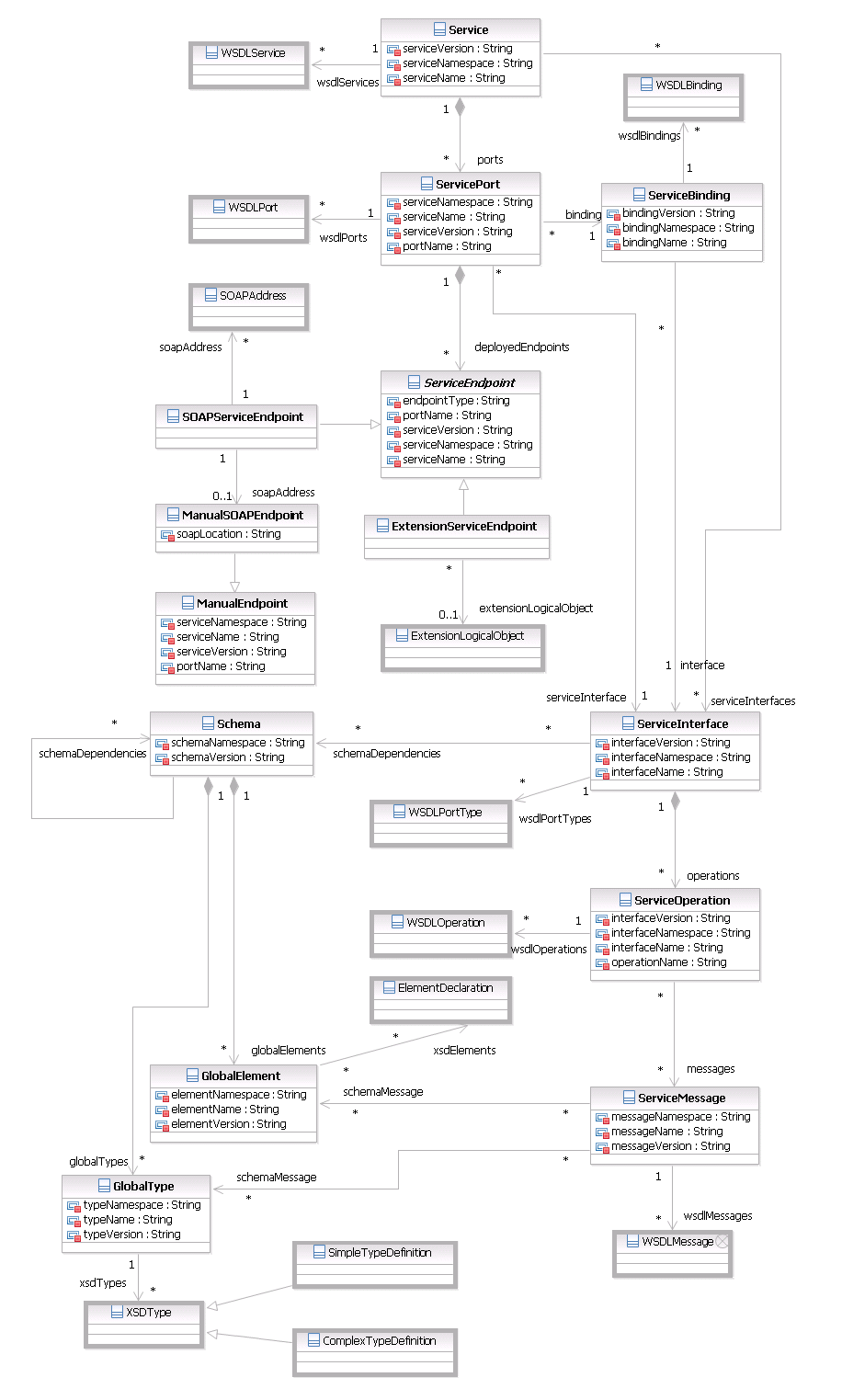The correlator modifier plug-in is provided with the governance enablement profile and is used to create WSRR business model objects (part of the WSRR Technical Model) called correlator objects; these group together various objects in WSRR.
- Service
- ServiceInterface
- ServicePort
- ServiceBinding
- ServiceOperation
- ServiceMessage
- SOAPServiceEndpoint
- ExtensionServiceEndpoint
- GlobalType
- GlobalElement
- Schema
- ServiceModule
- SCAExport
- SCAServiceEndpoint
When a WSDL document, XSD document, or SCA module is loaded into the WSRR, the correlator modifier plug-in parses the document and, for each of the logical objects derived from the WSDL document, XSD document, or SCA module, it creates a corresponding correlator object (if such an object does not already exist). In addition, a custom relationship is created from the correlator object to the WSRR logical object.
Certain properties of the WSDL, XSD or SCA logical objects are defined to be correlation properties. When the correlator object is created, these properties are also added to the correlator object, and the same values are assigned. If a logical object is derived from a newly loaded WSDL document, XSD document, or SCA module, and there is already an existing correlator object with the same values for the correlation properties, no new correlator object is created. The correlation properties vary according to the element type, as described in Tables 1, 2, and 3.
If a WSDL or XSD document is updated with the exact same content, then the Correlator Modifier does not run, and therefore does not re-correlate any objects, or recreate any objects that might have been deleted since the document was first loaded.
| WSDL logical object | Correlator object created | Correlation properties |
|---|---|---|
| Service | Service | The Service name, namespace, and version. |
| Port type | ServiceInterface | The Port type name, namespace, and version. |
| Port | ServicePort | The Port name. The name, namespace, and version of the Service from which the Port is derived. |
| Binding | ServiceBinding | The Binding name, namespace, and version. |
| Operation | ServiceOperation | The Operation name. The name, namespace, and version of the Port type from which the Operation is derived. |
| Message | ServiceMessage | The Message name, namespace, and version. |
| SOAP address | SOAPServiceEndpoint | The name, namespace, and version of the
Service from which the SOAP Address is derived. The name of the Port from which the SOAP address is derived. The type of the Service endpoint from which the SOAP address is derived. |
| ExtensionLogicalObject | ExtensionServiceEndpoint | The name, namespace, and version of the
Service from which the ExtensionLogicalObject is derived. The name of the Port from which the ExtensionLogicalObject is derived. The type of the Service endpoint from which the ExtensionLogicalObject is derived. |
| XSD logical object | Correlator object created | Correlation properties |
|---|---|---|
| Simple type | GlobalType | The Simple type name, namespace, and version. |
| Complex type | GlobalType | The Complex type name, namespace, and version. |
| Element | GlobalElement | The Element name, namespace, and version. |
| SCA logical object | Correlator object created | Correlation properties |
|---|---|---|
| Module | ServiceModule | namespace, sm63_versionValue, sm63_versionProvider |
| Export | SCAExport | sm63_exportName, namespace, version |
| ExportBinding | SCAServiceEndpoint | sm63_serviceName, sm63_serviceNamespace, sm63_serviceVersion, sm63_endpointType |
| Binding type | Service Endpoint created |
|---|---|
| Web services for SOAP 1.1 | SOAPServiceEndpoint |
| Web services for SOAP 1.2 | ExtensionServiceEndpoint |
| Native SCA | SCAServiceEndpoint |
| JMS | SCAServiceEndpoint |
| Generic JMS | SCAServiceEndpoint |
| MQSeries JMS | SCAServiceEndpoint |
| MQSeries | SCAServiceEndpoint |
| HTTP | SCAServiceEndpoint |
In addition, a Schema correlator object is created to reference, through custom relationships, all GlobalType and GlobalElement correlator objects that have the same namespace and version. The correlation properties are the namespace and version of the referenced GlobalType and GlobalElement objects.
- Example
- If a WSDL document is loaded that contains a Port type, the correlator checks whether a ServiceInterface correlator object exists for which the name, namespace, and version properties have the same values as those of the port type. If such an object exists, no new correlator object is created. If no such object exists, the correlator creates a new ServiceInterface correlator object with name, namespace, and version properties of the same value as the Port type, and adds a custom relationship from the correlator object to the WSDL Port type logical object.
The relationships between the correlator objects and the other WSRR objects are shown in the following diagram:

If you are using the governance enablement profile, the correlator modifier is enabled by default, but does not run when you import objects into WSRR.